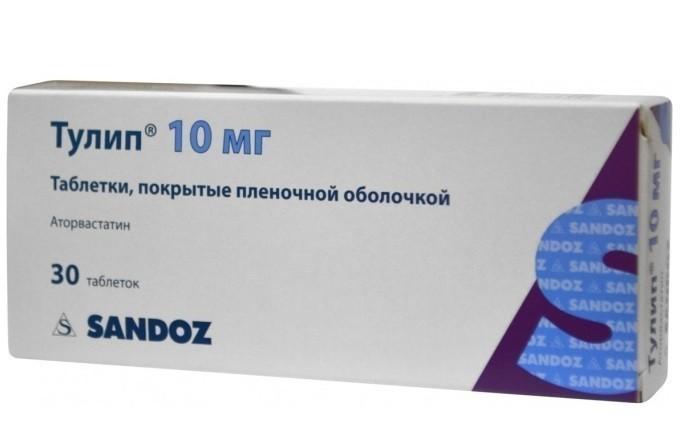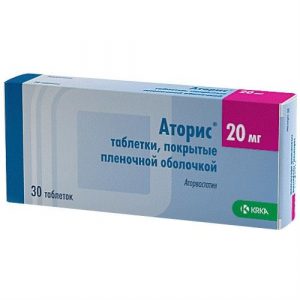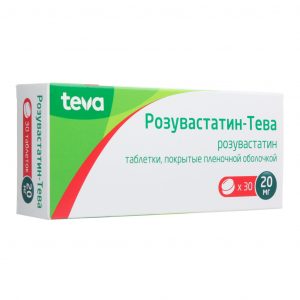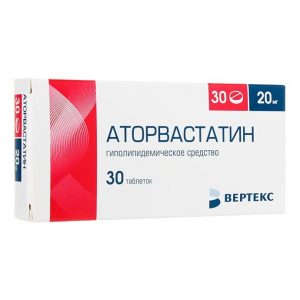Description
Latin name
Tulip
Release form
Coated tablets.
Packing
30 pcs
Indications
Primary hypercholesterolemia (according to Fredrickson type IIa)
Combined hyperlipidemia (according to Fredrickson type IIb)
Heterozygous and homozygous familial hypercholesterolemia (as an adjunct).
Contraindications
liver disease in the active stage (including active chronic hepatitis, chronic alcoholic hepatitis)
liver failure
increased activity of hepatic transaminases of unknown origin (more than 3 times compared with the upper limit of normal)
pregnancy (breastfeeding)
hypersensitivity to the components of the drug.
The drug is not prescribed for women of reproductive age who do not use adequate methods of contraception.
Tulip should be prescribed with caution in cases of alcohol abuse, a history of liver disease, severe electrolyte imbalance, endocrine and metabolic disorders, arterial hypotension, severe acute infections (including sepsis), uncontrolled epilepsy, skeletal muscle diseases, extensive surgery , injuries, as well as children.
Pregnancy and lactation
Pregnancy and lactation are contraindicated.
Composition of
1 tablet contains:
Active ingredient: atorvastatin (in the form of calcium salt) 10 mg
Excipients: microcrystalline cellulose, lactose monohydrate, croscarmellose sodium, hydroxypropyl cellulose, magnesium sulfate, magnesium sulfate Shell composition: hypromellose, hydropropyl cellulose, titanium dioxide (E171), polyethylene glycol 6000, talc.
Dosage and administration of
Before starting treatment, the patient should be switched to a low cholesterol diet. Inside, at any time of the day, regardless of food intake.
The dose of the drug varies from 10 to 80 mg once a day, selecting it taking into account the initial levels of LDL-C, the purpose of therapy and the individual effect. The dose should be changed with an interval of at least 4 weeks.
Primary hypercholesterolemia and mixed hyperlipidemia
The recommended starting dose of Tulip ® is 10 mg once daily. Then the dose is individually selected, component of 10 80 mg of the drug per day, depending on the target cholesterol level and the effectiveness of the drug. After 2-4 weeks after the start of treatment and / or selection of a dose of Tulip ®, it is necessary to determine the level of blood lipids and adjust the dose of the drug in accordance with it.
Familial hypercholesterolemia is heterozygous. The initial dose of Tulip ® is 10 mg per day, the dose can be increased to 80 mg per day.
is homozygous. The dose range is the same as with other types of hyperlipidemia. The initial dose is selected individually depending on the severity of the disease. The maximum daily dose is 80 mg.
Dosages for patients with renal failure. If the patient has kidney disease, the concentration of atorvastatin in the blood plasma and its effect on LDL cholesterol do not change.and kidneys are not required.
Dosages for patients with hepatic impairment. In patients with impaired liver function, caution must be exercised in connection with a slowdown in the elimination of the drug from the body. Clinical and laboratory parameters should be carefully monitored and, if significant changes are detected, the dose should be reduced or treatment should be discontinued.
Patients in the older age group. Dose adjustment for patients older than 70 years is not required.
Side effects
Digestive system: in more than 2% of cases – nausea in less than 2% – heartburn, constipation or diarrhea, flatulence, abdominal pain, anorexia, decreased or increased appetite, dry mouth, belching, dysphagia, vomiting, stomatitis, esophagitis, glossitis, erosive and ulcerative lesions of the oral cavity, gastroenteritis, hepatitis, biliary colic, cheilitis, duodenal ulcer, pancreatitis, cholestatic jaundice, impaired liver function, melena, bleeding gums, tenesmus.
Respiratory system: in more than 2% of cases – bronchitis, less often rhinitis – pneumonia, dyspnea, bronchial asthma, nosebleeds.
Nervous system: in more than 2% of cases – insomnia, dizziness in less than 2% – headache, asthenia, malaise, drowsiness, unusual dreams, paresthesias, amnesia, emotional lability, peripheral neuropathy, ataxia, facial paralysis, hyperkinesis, depression, hyperesthesia, loss of consciousness.
Musculoskeletal system: in more than 2% of cases – arthritis in less than 2% – leg muscle cramps, bursitis, tenosynovitis, myositis, myopathy, arthralgia, myalgia, joint contractures, stiff neck, rhabdomyolysis.
Allergic reactions: in less than 2% of cases – itchy skin, rash, contact dermatitis rarely – urticaria, anaphylaxis, Quincke edema, erythema multiforme exudative (Stevens-Johnson syndrome), toxic epidermal necrolysis (Lyell’s syndrome), photosensitivity.
Skin: in less than 2% of cases – alopecia, sweating, eczema, seborrhea, ecchymosis, petechiae.
Genitourinary System: in more than 2% of cases – urogenital infections, peripheral edema in less than 2% of cases – dysuria (including pollakiuria, nocturia, urinary incontinence or urinary retention, mandatory urination), nephritis, hematuria, vaginal bleeding, urolithiasis, epididymitis, decreased libido, impaired ejaculation, impotence, uterine bleeding.
Sensory organs: in less than 2% of cases – amblyopia, tinnitus, dry conjunctiva, disturbance of accommodation, hemorrhage in the eyes, deafness, increased intraocular pressure, parosmia, taste perversion, loss of taste sensations.
Cardiovascular system: in more than 2% of cases – chest pain in less than 2% – palpitations, vasodilation, orthostatic hypotension, phlebitis, arrhythmia, angina pectoris, increased blood pressure.
Hematopoietic system: in less than 2% of cases – anemia, lymphadenopathy, thrombocytopenia.
Laboratory indicators: in less than 2% of cases – hyperglycemia, hypoglycemia, increased levels of creatine phosphokinase (CPK), albuminuria.
Other: in less than 2% of cases – weight gain, gynecomastia, exacerbation of gout, mastodynia.
Drug Interaction
Antacids: with atorvastatin and antacid preparations in the form of a suspension containing magnesium and aluminum hydroxides, the concentration of atorvastatin in the blood plasma decreases by approximately 35%, with the degree of decrease in the level of cholesterol.
Colestipol: atorvastatin and colestipol concomitantly reduce blood plasma concentrations of atorvastatin by approximately 25%, the hypolipidemic effect of the combination of atorvastatin and colestipol exceeds that of each drug individually.
Digoxin: with multiple concomitant administration of atorvastatin and digoxin, the plasma concentration of digoxin is increased by about 20%, and therefore the patient should be monitored.
Erythromycin: concomitant administration of atorvastatin with erythromycin exerting an inhibitory effect on cytochrome P450 CYP3A4 increases the concentration of atorvastatin in blood plasma by approximately 40%.
Oral contraceptives: with concomitant use of atorvastatin and oral contraceptives, AUC values are increased by approximately 30% for norethisterone and 20% for ethinyl estradiol. These data should be considered when selecting contraceptives for patients, receiving atorvastatin.
Warfarin: in patients receiving warfarin for a long time, atorvastatin decreases prothrombin time somewhat in the first days after its administration, however, after 15 days, this rate normalizes. Patients receiving warfarin should be monitored more frequently than usual after administration of atorvastatin.
Concurrent administration of cyclosporine, fibrates, clarithromycin, antifungal drugs (azole-related) and nicotinamide increases the concentration of atorvastatin in blood plasma (risk of myopathy).
Overdose
There is no specific treatment for overdose with Tulip. Treatment is symptomatic by taking measures to maintain vital functions and prevent further absorption of the drug (gastric lavage, activated charcoal intake). Due to the fact that the drug actively binds to plasma proteins, hemodialysis does not seem to be an effective way to accelerate its excretion.
Storage conditions
At a temperature not exceeding 25 ° C.
Expiration
2 years.
Deystvuyuschee substances
Atorvastatin
Terms of delivery from
pharmacies Prescription
Dosage form
dosage form
tablets
Sandoz, Switzerland




